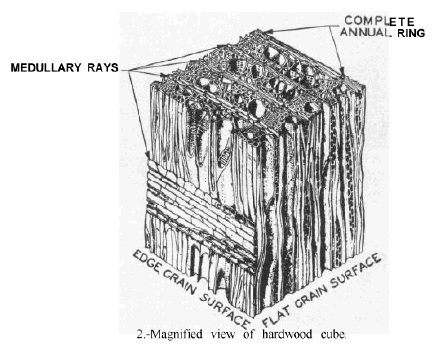
TM 1-414
AIRCRAFT WOODWORK 2-4
difference between the color of the heartwood and the sapwood. After timber is seasoned, the heartwood is usually more resistant to decay, stain, mold, and to the attack of certain insects, than is the sapwood; whereas, in the living tree the opposite is true.
b. The bark serves as a protective covering for the tree. The cells of the sapwood function mainly in the movement and storage of food.
Some of these cells are alive but most of them are dead, acting only as passages for sap and adding to the strength of the trunk. The cells of the heartwood are dead and function only in supplying strength to the trunk.
3. Classification. -Woods are generally grouped as hardwoods or softwoods. Hardwoods come from broadleafed trees and include ash, birch, basswood, mahogany, maple, walnut, etc. Softwoods come from trees with needlelike or scalelike leaves (evergreens), commonly known as conifers, and include fir, pine, cypress, and spruce.
In some instances the terms are not descriptively exact since yellow pine, generally classified as a softwood, is in reality harder than basswood, which is classified as a hardwood. However, as a result of long usage, the terms have become definitely established.
MEDULLARY RAYS

FIGURE 2.-Magnified view of hardwood cube.
4. Cellular structure .-a. Figure 2 shows the magnified cell structure of a cube of hardwood. Wood is composed of many different sizes and shapes of cells all tightly grown together. The substance of which these cells are made is substantially the same in all species of woods, but the size and arrangement of the cells vary greatly with the different woods. It is this difference in the size, thickness of cell walls, and